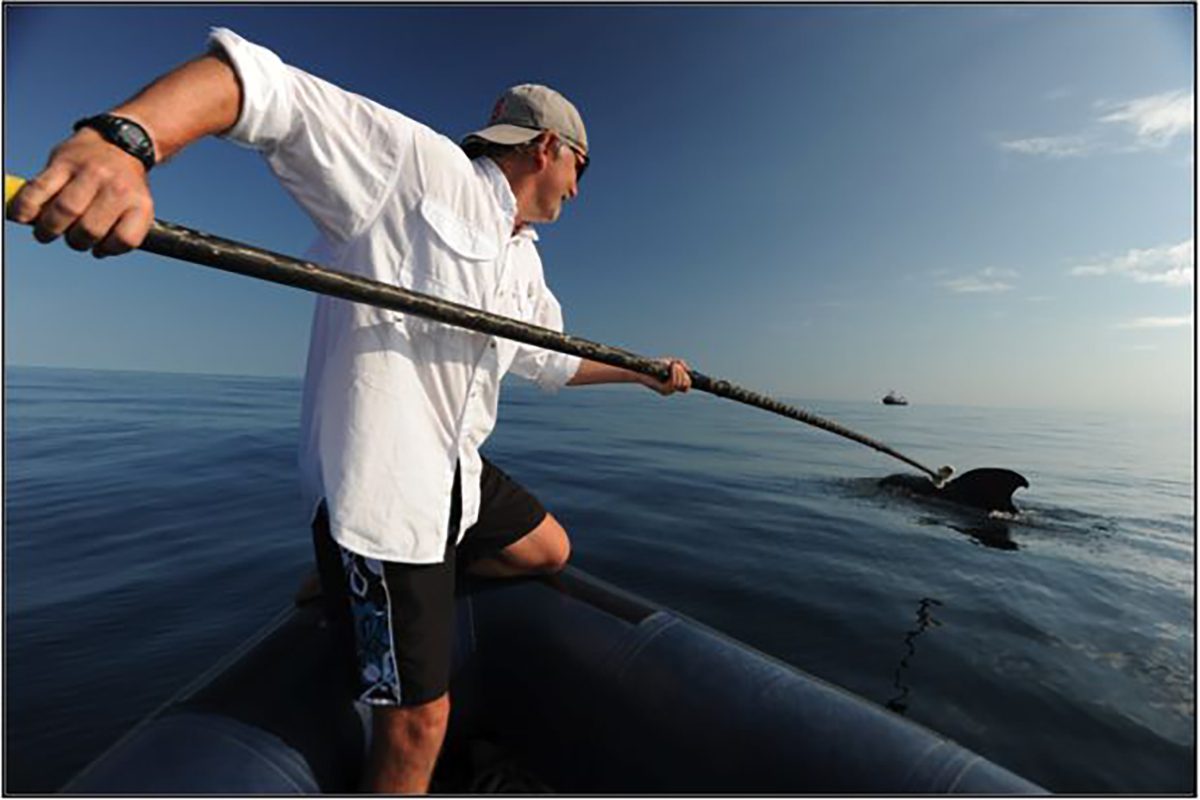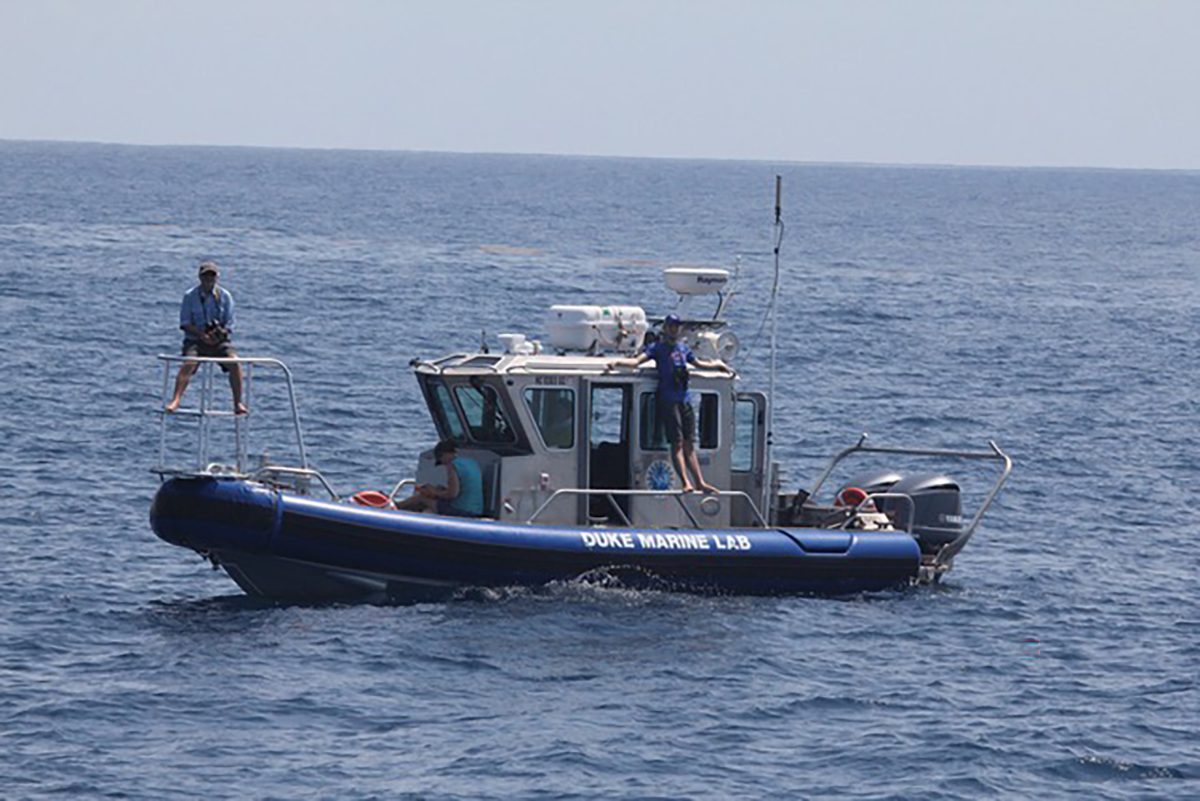
Dr. Andy Read’s first encounter with a whale was, in his words, “the most gross, disgusting thing I’ve ever seen.”
He was a college student who had just landed a job with the Ontario Science Centre in Toronto, Ontario, Canada, putting together the skeleton of a beached fin whale that couldn’t be saved.
Supporter Spotlight
The catch? The center’s team hadn’t been able to fully clean the skeleton before they brought it back from Nova Scotia, and it was buried somewhere in Toronto until they had the time to finish the process – that was Read’s job. “I almost quit the first day,” he said.

It’s a good thing he didn’t. Read’s close encounter with that whale skeleton fascinated him and was the beginning of a prolific career. Now the Stephen A. Toth Professor of marine biology at Duke University and director of the Duke University Marine Lab in Beaufort, Read studies the ecology and conservation of whales and other marine mammals.
Read’s move to North Carolina was a geographic stroke of luck. After completing his doctorate at the University of Guelph in Ontario, where he studied harbor porpoises in the Bay of Fundy, he took a postdoctoral position at Woods Hole Oceanographic Institution in Massachusetts.
During that time, he met his wife, Kim Urian, who was working at the Mote Marine Lab in Florida. The distance was a challenge, and the pair agreed to settle down somewhere in the middle. Read started at Duke in 1995.
North Carolina has been the perfect place for Read to pursue his research and conservation work. “It’s just a great place to do what I do. We have lots of access to marine mammals and sea turtles here,” he explained.
Supporter Spotlight
The diversity of animals he encounters in his research is a big perk, and another geographic stroke of luck: North Carolina sits at the confluence of the tropical Gulf Stream and the boreal Labrador Current. This brings a huge diversity of animals to our waters, which host 36 species of marine mammals and five of the six species of sea turtles found in the United States.

Navy sonar study
Read is currently leading U.S. Navy-funded research on one of these 36 marine mammal species, the Cuvier’s beaked whale, also known as the goose-beaked whale, off the coast of Cape Hatteras. His team is working to understand how and why the midfrequency active sonar the Navy uses to detect small submarines affects the behavior of these whales. Cape Hatteras is a great place for this study because it has a high density of beaked whales and a relatively low level of Navy training activity.
Cuvier’s beaked whales are both the deepest-diving mammal in the world and the mammal capable of staying underwater the longest. They use their exceptional abilities for hunting — according to Read, they forage at an average depth of about 1,500 meters, or close to a mile, but they can descend to depths twice that.
In 2020, a team of researchers including Read recorded a Cuvier’s beaked whale dive that lasted 222 minutes – over three and a half hours. “It’s like running a 5K, taking a breath when the starting gun goes off, and you don’t take another breath until the end of the race,” said Read. “Which is just … How does a mammal do that? They shouldn’t be able to!”
Unfortunately, midfrequency active sonar alters these impressive diving behaviors. Cuvier’s beaked whales that hear the sonar tend to surface very quickly, interrupting their hunting and putting them in physiological danger from decompression sickness. Read and his team think this is because the sonar sounds like killer whale calls. Killer whales are the only natural predators of Cuvier’s beaked whales. They don’t usually dive very deep, which must make hearing their calls thousands of meters below the surface extra disconcerting for the Cuvier’s beaked whales.
“When they’re foraging … where they should be safe from killer whales, all of the sudden they hear the sounds of their predators, and they panic,” Read said. The team’s most recent experiment took place with the help of the USS Farragut, a Navy destroyer, in August 2022. They hope to continue their work until at least 2025.
Read and his students are also studying the ecology of short-fin pilot whales and bottlenose dolphins off Cape Hatteras. He’s also been involved in marine mammal studies all over the world, including a project on humpback whales in Antarctica. “But now that I’m director of the (Duke Marine) lab here, it’s hard to get away for a couple months every winter” to do that research, he said.

It’s not just the director’s job that keeps him busy. Read has also recently been appointed by President Biden as one of three commissioners of the federal Marine Mammal Commission.
The commission was established in 1972 as part of the Marine Mammal Protection Act. It is charged with oversight of all marine mammal research and conservation initiatives in the country, most of which are performed by the U.S. Fish and Wildlife Service and the National Oceanic and Atmospheric Administration, or NOAA.
While Read had previously served on the commission’s committee of scientific advisers from 2003-2008, this is the first time he has been confirmed by the Senate as commissioner. He was also nominated by President Obama, but never confirmed.
One of the commission’s species of concern – and a personal one for Read as well – is the North Atlantic right whale. “The population is declining, we have fewer than 400 whales left, fewer than 70 adult female whales,” he said.
North Carolina is an important migratory corridor for the species. North Atlantic right whales travel yearly between their feeding grounds in New England and Canada and their breeding grounds off the coast of Georgia and eastern Florida.
One major threat to right whales is entanglement in fishing gear. Ship strikes are another, and are particularly relevant in North Carolina. There are already seasonal restrictions on large ships coming into North Carolina ports in Morehead City and Wilmington. Those restrictions may soon affect smaller ships as well, if changes proposed by NOAA Fisheries to the existing right whale vessel speed rule go through.
“It’s seasonal, so it’s only from November through April. But we have a big bluefin tuna fishery here in some years … We’re very interested to see what NOAA Fisheries decides to do with that rule. That’ll have an impact here locally,” Read explained.
A necessary challenge
Balancing conservation and industry is a necessary challenge, and one Read readily takes on.
Early in his career he helped develop and test small pinging alarms to warn dolphins and porpoises away from gillnets. These pingers are now used by fishers around the world, and when used properly they can reduce bycatch of porpoises by about 90%.
“I think that’s the thing, probably, I’m most proud of, and working directly with fishermen has been challenging, but it can also be very rewarding,” Read, who speaks admirably about the ingenuity of the fishers he has worked with throughout the years. said.
Fisheries and coastal management can be a complex but critical undertaking, particularly when there are endangered species like right whales plying the waters. After decades in the field, Read remains hopeful that society can figure out some of these pressing conservation issues.
“We are industrializing the coastal ocean. But we have so many resources in this country and such good legislative frameworks through the Marine Mammal Protection Act and the Endangered Species Act,” he explained. However, simply having those frameworks is not enough – we also need the political will to find a way to coexist with marine mammals, he stressed.
So how can the average North Carolinian help on a daily basis? According to Read, figure out where the shrimp, tuna and other seafood you eat comes from, and seek out seafood that’s harvested in a way that has a “gentle, light touch on the environment.”
Despite our state’s abundant marine resources, much of the seafood we eat still isn’t locally or sustainably harvested. Consumers’ small changes could make a big difference for marine ecosystems and local fishers alike. “It’s worth a little investment. We should all think about where our food comes from,” said Read.








